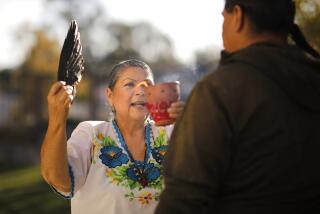Faith-Healing Center Claims 100% Cures
- Share via
ABADIANIA, Brazil — Ivo Pereira Correa stood against the whitewashed wall under a portrait of the Virgin Mary, his eyes tightly shut.
The man standing opposite him drew a pair of long scissors from a surgical tray and clamped a white swab in their tip. Suddenly, he rammed the scissors up Pereira’s left nostril as far as they would go, twisting and turning them.
Pereira’s face contorted in a silent grimace. Out came the scissors. A stream of blood poured to the floor. Pereira slumped to the ground and was carried away.
John of God, Brazilian spiritual healer, had completed another operation.
“At the moment of the operation I am asleep,” the 46-year-old “doctor,” whose real name is Joao Teixeira, told Reuters. “I am unconscious. I see nothing. The spirits perform the operation.”
His ways may be unconventional--trances for anesthesia, steak knives for scalpels and prayers instead of antiseptic--but there is no denying his popularity.
Sick men and women come from as far away as Peru and Ecuador to the simple, single-story buildings where he practices in Abadiania, a town 75 miles from Brasilia.
“Joao is very well known in our country,” said Anselmo Vargas Aguirre of Arequipe, Peru. “He once came and tried to practice there, but the authorities would not let him. So we come here instead.”
Teixeira, a plump man in white trousers with long, untidy hair and silver-rimmed eyeglasses, treats about 2,500 people a day three days a week at his center--for free. He makes a living from a 2,500-acre cattle ranch and an emerald claim.
His center is dedicated to St. Ignatius of Loyola, founder of the Jesuit priests in the 16th Century, although it has no link to the Jesuits other than Teixeira’s claim to embody Loyola’s healing spirit.
There is no shortage of people here who claim to be living proof that Teixeira’s methods work.
“I first came here 12 years ago almost dead from liver cancer,” said Ayrton Elias Antares, a fit-looking retired army officer. “I weighed just 84 pounds and the doctors had sent me home from hospital to die. Within three months I was cured by Joao’s invisible healing.”
Sebastiao da Silva Lima, Teixeira’s assistant, pointed proudly to a glass-front wooden cabinet in his dusty office. On its shelves were a collection of sealed jam jars filled with rubbery-looking lumps in clear liquid.
“These are the cancers Joao has removed from his patients,” Sebastiao said. “Each one has its own story. . . . This one came out of a Bolivian’s back. It weighs 2.5 pounds. Those little white bits . . .that was a uterine cancer.”
Treatment is prompt. Patients file through Teixeira’s consulting room, decorated with red roses and religious icons and filled with white-robed, praying media who “transmit energy to the patients during their spiritual cleansing,” Teixeira says.
With barely a glance at each patient, Teixeira makes snap decisions. “You are cured. Go home,” he tells one crippled man, and flings his crutches to the floor. The invalid shuffles off, looking surprised.
A woman complains of an eye ailment. Teixeira seats her in a chair, whips out a steak knife and scrapes quickly at her eye. “Go home,” he tells her, and he tosses the knife onto a table. The woman staggers away, fluid streaming from the eye.
Teixeira said he started practicing at age 16, after an apparition came to him while he was working as a tailor.
Teixeira avoids questions about his diagnoses or methods of treatment. “I am not a doctor, I do not do anything,” he repeats. “It is the center which treats people.”
He insists he has never known a failure. “In 34 years of my mission this has never happened,” he said. “If it had, you wouldn’t see all these people here.”
More to Read
Sign up for Essential California
The most important California stories and recommendations in your inbox every morning.
You may occasionally receive promotional content from the Los Angeles Times.













